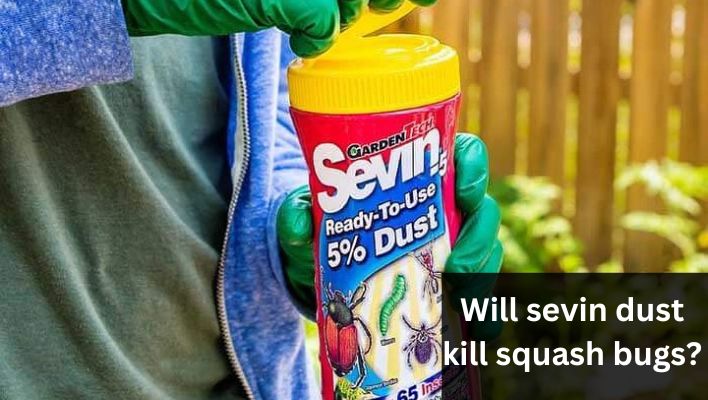Squash bugs are one of a gardener’s worst nightmares, wreaking havoc on our beloved squash plants. These pesky insects, known for their destructive nature, can quickly decimate an entire crop if left unchecked.
These pesky insects have a knack for wreaking havoc on squash plants, causing frustration and disappointment for those who have put in countless hours of care and nurturing.
But fear not, as there is a potential solution that can come to the rescue: Sevin Dust. Now, I know what you’re thinking: Will Sevin Dust do the trick? Will it finally put an end to these squash bug nightmares?
Well, my friend, that’s exactly what we’re going to explore in this article. Sevin Dust has gained popularity as a reliable insecticide for pest control, and many gardeners swear by its effectiveness.
We’ll dig deep into the world of squash bugs, their impact on your plants, and whether Sevin Dust is the ultimate squash bug assassin we’ve all been waiting for.
Understanding Squash Bugs
Before we delve into the effectiveness of Sevin Dust against squash bugs, let’s get to know our enemy a little better. These critters may be small, but their impact on your squash plants can be mighty.
Appearance-wise, squash bugs are flat, shield-shaped insects with a dark brown or grayish-black color. They typically measure around half an inch in length.
You might notice their distinct feature—a triangle-shaped plate just behind their head, creating a signature “X” mark. Don’t be fooled by their unassuming size; these bugs are masters of disguise, blending in seamlessly with the foliage of your squash plants.
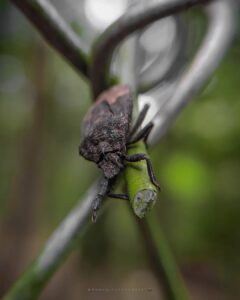
As for their behavior, squash bugs are survival experts. They are most active during warm weather, thriving in the summer months when your squash plants are at their prime. These pests are skilled hiders, taking cover in the nooks and crannies of your garden, making them a challenge to spot.
Now, let’s talk about the damage they can inflict on your squash plants. Squash bugs are not to be taken lightly. They have a voracious appetite for both the leaves and fruits of your beloved squashes. They pierce the plant tissue with their needle-like mouthparts, sucking out the sap and causing significant damage.
The first signs of a squash bug infestation include wilting or browning of leaves, which can quickly progress to complete plant decline if left unchecked. Additionally, squash bugs have a notorious reputation for transmitting disease-causing bacteria, further compromising the health of your plants.
It’s clear that these little invaders can wreak havoc on your squash garden, but fear not! With the right knowledge and strategies in place, we can turn the tide in our favor.
What is Sevin Dust?
When it comes to battling garden pests like squash bugs, Sevin Dust is a name that often pops up in gardening circles. But what exactly is Sevin Dust, and how does it work its magic?
Sevin Dust is a broad-spectrum insecticide that has been trusted by gardeners for decades. It contains an active ingredient called carbaryl, which is responsible for its pest-fighting prowess. Carbaryl belongs to a group of chemicals called carbamates, known for their effectiveness in targeting a wide range of garden pests.
So, how does Sevin Dust work its wonders? Well, when applied to your plants, it adheres to the leaves and other surfaces, creating a protective barrier. When squash bugs come into contact with Sevin Dust, they absorb the carbaryl through their body, leading to the disruption of their nervous system. This disruption results in paralysis and, ultimately, the demise of these unwanted guests.
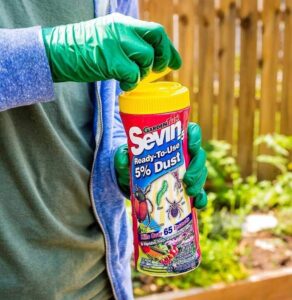
One of the key factors contributing to Sevin Dust’s effectiveness is its ability to provide both contact and residual control. This means that it not only kills pests on contact but also continues to protect your plants from future infestations for a certain period. That’s like having a trusted guardian watching over your squash plants!
Using Sevin Dust for pest control comes with a range of benefits. Firstly, it offers a quick and efficient solution to combat squash bugs and other pesky insects. You can witness its impact within a relatively short time, bringing relief to your garden and allowing your plants to thrive.
Additionally, Sevin Dust’s broad-spectrum nature means that it doesn’t just target squash bugs but can also tackle other common garden pests like aphids, beetles, and leafhoppers. It’s like having an all-in-one defense system against a multitude of garden invaders.
How Sevin Dust Kills Squash Bugs
Now that we understand what Sevin Dust is, let’s uncover how it works its magic on those pesky squash bugs. To truly appreciate its effectiveness, we need to explore its mode of action and why squash bugs are particularly vulnerable to its active ingredient, carbaryl.
Squash bugs are particularly vulnerable to the active ingredient in Sevin Dust, carbaryl. This vulnerability stems from their physiological makeup and the specific way carbaryl affects their nervous system.
When squash bugs come into contact with Sevin Dust, the carbaryl is absorbed through their body, leading to a series of events that disrupt their nervous system. The nervous system of insects plays a crucial role in coordinating their movements and bodily functions.
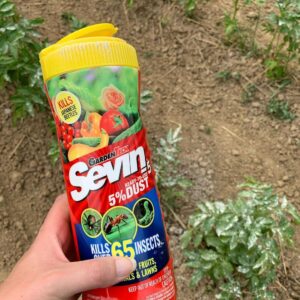
Carbaryl interferes with an enzyme called cholinesterase, which is essential for normal nerve function. By inhibiting this enzyme, carbaryl disrupts the transmission of nerve impulses in squash bugs, essentially causing communication breakdown within their nervous system.
This disruption leads to a cascade of effects, including paralysis and the inability of squash bugs to perform vital functions like feeding and mating. In essence, Sevin Dust turns their nervous system against them, rendering them helpless and ultimately leading to their demise.
But why are squash bugs particularly vulnerable to carbaryl? It turns out that these pests have a higher susceptibility to carbamate insecticides like carbaryl compared to some other insects. This vulnerability is due to differences in their enzyme systems, making them more receptive to the effects of carbaryl.
So, when you apply Sevin Dust to your squash plants, you’re essentially deploying a powerful weapon that targets the nervous system of squash bugs, disrupting their vital functions and effectively eliminating their presence.
How to Apply Sevin Dust for Squash Bugs
Using Sevin Dust effectively requires proper application techniques and adherence to safety precautions. Let’s walk through the step-by-step process to ensure optimal results in combatting squash bugs:
Preparation
- Choose a calm, dry day for the application to minimize drift and ensure maximum coverage.
- Put on protective clothing, including long sleeves, pants, gloves, and a face mask, to minimize direct contact with the insecticide.
Read the Label
- Carefully read and follow the instructions provided on the Sevin Dust label. This ensures you use the correct dosage and application method for your specific situation.
Mixing
- If required, mix the Sevin Dust with water according to the label instructions. Some formulations may already come in a ready-to-use form, eliminating the need for mixing.
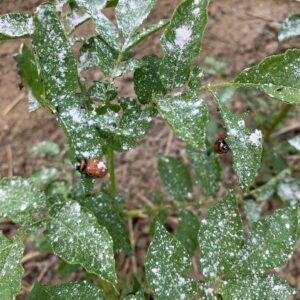
Application
- Start by gently shaking or stirring the Sevin Dust to ensure even distribution.
- Using a handheld duster or a dust applicator, apply a light, even layer of Sevin Dust to the affected areas of your squash plants, paying attention to the stems, leaves, and other plant surfaces where squash bugs are commonly found.
- Make sure to cover both the upper and lower sides of the leaves, as well as the base of the plant.
Avoid Overapplication
- Remember that more is not always better when it comes to insecticides. Avoid excessive application of Sevin Dust, as it may lead to phytotoxicity or harm beneficial insects.
Safety Precautions
- After application, thoroughly wash your hands, arms, and any exposed skin.
- Remove and launder your protective clothing separately to prevent any potential contamination.
- Keep children and pets away from treated areas until the dust has settled or dried, as directed by the label instructions.
Timing and Frequency
- The ideal timing for the Sevin Dust application is when you first notice squash bugs or their eggs on your plants.
- Depending on the severity of the infestation, you may need to reapply Sevin Dust every 7 to 14 days. However, always refer to the label instructions for the recommended frequency.
By following these step-by-step instructions, adhering to safety precautions, and applying Sevin Dust at the right time and frequency, you can maximize its effectiveness in controlling squash bugs and protecting your precious squash plants.
Remember, always refer to the specific instructions on the Sevin Dust label for the most accurate and up-to-date guidance. Now, armed with this knowledge, you’re ready to take on those pesky squash bugs and restore the health and beauty of your garden!
Other Methods for Controlling Squash Bugs
While Sevin Dust can be an effective tool in the battle against squash bugs, it’s always good to have a few alternatives up your sleeve. Here are some other methods you can consider incorporating into your pest control strategy:
- Handpicking: This method involves manually removing squash bugs from your plants. Wear gloves and carefully inspect the leaves, stems, and undersides for any signs of squash bugs or their eggs. Drop them into a bucket of soapy water to ensure they won’t return.
- Row Covers: Using row covers can act as a physical barrier, preventing squash bugs from reaching your plants. Be sure to secure the covers tightly to prevent any gaps or openings that may allow the pests to sneak through.
- Companion Planting: Some plants, such as marigolds, nasturtiums, and tansy, have natural repellent properties that deter squash bugs. Consider interplanting these companion plants among your squash to help keep the bugs at bay.
- Neem Oil: Neem oil, derived from the neem tree, is an organic option that can disrupt the life cycle of squash bugs. Dilute the neem oil according to the instructions and spray it on the affected plants, paying attention to the undersides of the leaves.
- Insecticidal Soaps: These soaps are specially formulated to target soft-bodied insects like squash bugs. Mix the soap with water as directed and apply it to your plants, focusing on the areas where the pests congregate.
- Beneficial Insects: Encourage the presence of beneficial insects, such as ladybugs and lacewings, which are natural predators of squash bugs. Planting flowers that attract these beneficial insects can help create a more balanced ecosystem in your garden.
- Diatomaceous Earth: Diatomaceous earth is a natural powder made from fossilized remains of marine organisms. It acts as a physical barrier, dehydrating and piercing the exoskeletons of squash bugs when they come into contact with it. Lightly dust the powder on and around your plants, focusing on the areas where squash bugs are commonly found.
- Trap Crops: Planting trap crops, such as Hubbard squash or zucchini, can lure squash bugs away from your main squash plants. The idea is to sacrifice these trap crops as a preferred feeding and egg-laying site for the pests while protecting your desired squash plants.
- Organic Sprays: There are organic sprays available on the market that are specifically formulated to target squash bugs. These sprays typically contain botanical ingredients or oils that repel or suffocate the pests. Follow the instructions on the product label for proper application.
- Cultural Practices: Implementing good cultural practices can help minimize squash bug populations. Regularly remove plant debris and weeds, as they can provide hiding spots for squash bugs. Properly rotate your crops each year to reduce the likelihood of recurring infestations.
- Integrated Pest Management (IPM): Adopting an IPM approach involves combining multiple strategies and techniques to manage pest populations. This includes monitoring your plants regularly, using biological controls like beneficial insects, and resorting to chemical treatments only as a last resort.
- Vigilance and Early Detection: Regularly inspect your plants for any signs of squash bugs or their eggs. By catching the infestation early, you can take swift action and prevent it from spreading and causing extensive damage.
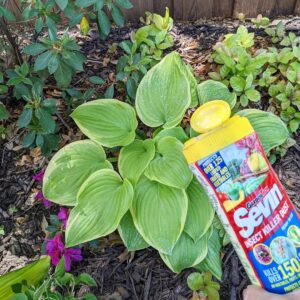
Remember, not all methods may work equally well in every situation, so it’s important to assess the effectiveness of each approach and adapt your strategy accordingly. By utilizing a combination of these methods and staying proactive, you’ll be better equipped to control squash bugs and safeguard the health of your squash plants.
Remember, each method has its advantages and limitations, and the effectiveness may vary depending on the severity of the infestation and other factors. It’s often best to combine multiple approaches for a comprehensive pest control strategy.
Choose the methods that align with your gardening philosophy and experiment to find the combination that works best for you. By diversifying your tactics, you’ll increase your chances of successfully managing squash bug populations and protecting your precious squash plants.
Will Sevin Dust kill Squash Bugs FAQs?
Can Sevin Dust be used on other plants?
Yes, Sevin Dust can be used on a variety of plants to control a wide range of garden pests. It is labeled for use on vegetables, fruits, ornamentals, and lawns.
However, it is important to always read the label instructions and follow them accordingly to ensure proper usage and avoid any potential damage to specific plant species.
Is Sevin Dust harmful to humans or pets?
Sevin Dust should be handled with care, as it is an insecticide. It is important to follow the safety precautions outlined on the product label.
When applying Sevin Dust, it is advisable to wear protective clothing, including gloves and a mask, to minimize direct contact with the product.
Additionally, it is recommended to keep children and pets away from treated areas until the dust has settled or dried, as directed by the label instructions.
Can Sevin Dust be used in organic gardens?
Sevin Dust contains carbaryl, which is a synthetic insecticide and not approved for use in certified organic gardening.
If you are following organic gardening practices, there are alternative methods and products available that are approved for organic use.
It is important to look for organic-certified insecticides and follow the guidelines set forth by organic gardening standards.
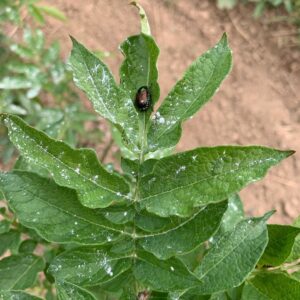
Can Sevin Dust harm other beneficial insects in the garden?
Yes, Sevin Dust is a broad-spectrum insecticide, meaning it can potentially harm beneficial insects along with the targeted pests.
Bees, ladybugs, lacewings, and other beneficial insects may be affected if they come into direct contact with the product.
To minimize harm to beneficial insects, it is advisable to apply Sevin Dust when the insects are less active, such as in the evening, and to avoid treating flowers that are in bloom and attracting pollinators.
How long does Sevin Dust remain effective?
The effectiveness of Sevin Dust can vary depending on factors such as weather conditions, the level of pest infestation, and the specific pest being targeted.
Generally, Sevin Dust provides both contact and residual control, offering immediate action upon application and continued protection for a certain period.
However, for optimal results, it is recommended to reapply Sevin Dust according to the label instructions, especially if squash bugs persist or if new infestations occur.
Conclusion
Sevin Dust has proven to be a powerful weapon in the battle against squash bugs. Its active ingredient, carbaryl, targets the nervous system of these pests, leading to their paralysis and eventual demise. Squash bugs, with their higher susceptibility to carbaryl, make them particularly vulnerable to the effects of Sevin Dust.
By applying Sevin Dust properly and following the recommended safety precautions, you can effectively control squash bug infestations and protect your precious squash plants.
Whether it’s the immediate action upon application or the residual control that provides ongoing protection, Sevin Dust has shown its effectiveness in combating these garden pests.
However, it’s important to remember that Sevin Dust is an insecticide and should be used responsibly. Take precautions to minimize harm to beneficial insects and follow the guidelines for application, timing, and frequency specified on the product label.
With Sevin Dust as a key component of your pest control strategy, along with other alternative methods and cultural practices, you can regain control of your squash plants and enjoy a beautiful and pests free garden.
